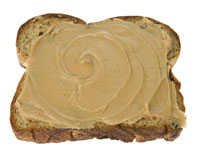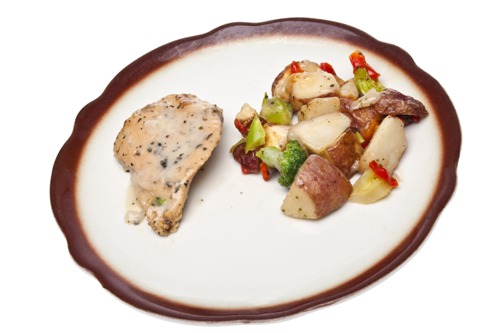As I mentioned in last week’s blog, exercise and wise dieting principles aren’t enough to help you reach your optimal weight. Portion control is essential.
Just how important is portion control? In one study, Cornell University researchers David Levitsky and Trisha Youn offered a group of students free lunch for several weeks. Everything the students consumed was secretly measured and weighed. Meanwhile, portions of soup, pasta, breadsticks and ice cream were increased significantly every week. Guess what happened: the students just ate whatever portions were served! The scientists concluded that portion size determines calorie intake.
Many of us have a problem with knowing when we are satiated. If you’d like to pay closer attention to the amount of food you consume at a meal, read on for serving sizes suggested by the American Dietetic Association. All of these serving sizes may be regarded as “approximate ounce equivalents.”
Breads, Cereals, Rice, and Pasta
Grains embody all aspects of a plant in seed form. They are generally regarded as being the food most balanced in Yin (cooling and eliminative) and Yang (warming and building) qualities. Select grains depending on your digestive strength (this is determined by such things as abdominal bloating or gas after meals): eat unrefined whole grains if you have strong digestion, or eat more refined grains if your digestion is weak.
One serving equals:
- 1 slice of bread, a about the size of a plastic CD case
- 1/2 cup of cooked rice, pasta, or cereal, about the size of a tennis ball
- 1 ounce of cold cereal
 Vegetables
Vegetables
Vegetables, especially above ground vegetables, generally supply the necessary yin, cooling and detoxifying aspects of our diet. Most root vegetables, on the other hand, tend to be warmer in energy, but perhaps not so warm as grains. As I mentioned in my last post, it’s important to have a balanced diet of yin/cool and yang/warm foods.
Vegetable servings are best measured in cups rather than ounces.
One serving equals:
- 1/2 cup of ovegetable juice or raw or cooked vegetables (about the size of a light bulb)
- 1 cup of leafy raw vegetables
 Fruits
Fruits
Fruit is the most cooling and eliminating food group in a balanced diet. They are also the most seasonally sensitive. Eating fruits as they are seasonally ripened in your area is a way to fine tune blood chemistry in terms of density and other chemical elements that help us to adjust to seasonal and climatic influences. People who live in the country appreciate this more than people who live in the city where awareness of seasonal limitations tends to be ignored in favor of year-round availability. Nevertheless, we all are affected by the barometric, climatic and other elements that are part of the cycle of life. Fruits that are not locally grown or out of season are not completely tree ripened and thus deprived of flavor and nutrients. Most of us can adapt to eating out of season fruits in modest portions. Because fruits come in so many different shapes and sizes, it’s hard to say how many pieces of fruit count as a serving.
One serving equals:
- 1 cup of fruit (about the size of 7 cotton balls or 1 baseball) or 100 percent fruit juice
- 1/2 cup of dried fruit
- 1 serving size of whole fruit (about the size of 1 tennis ball)
(Those who may be unable to consume the necessary daily intake of vegetables and fruit may try Planetary Herbals’ new Vita Greens & Berries that contains 59 fruits, vegetables, and immune factors that help you to meet daily fruit and vegetable needs. )
 Dairy Products – Milk, Cheese and Yogurt
Dairy Products – Milk, Cheese and Yogurt
A common mistake that many make is to use dairy for all their protein needs. Milk is just one molecule different from blood and so it is vitally important that we have the best quality dairy we can find. Ideally it should not be homogenized. Because of its congesting, mucus-forming properties, it should never be taken cold out of the refrigerator, but served warm. I have seen just this practice alone eliminate the symptoms of many who believed they were allergic to dairy.
Many people (especially those of African and Asian descent) are unable to digest the lactose in dairy. Rather than taking a lactase supplement, if would be best if these people would simply eliminate dairy entirely from their diet.
As we get older, our need for the body-building properties of milk is less, and it is better to receive the benefits of dairy from a probiotic cultured food such as yogurt. Because it is still dense and a bit congesting, yogurt should be avoided in the evening and is best taken midday. The same would apply to cottage cheese.
Because the fat globules are closer to those naturally occurring in human milk, goat’s milk is the best dairy to use. While for many the flavor of goat’s milk is not as appealing as that of cow’s milk, goat cheese seems to meet with a lot less resistance and is even preferred.
Choose low-fat options from this group whenever possible.
One serving equals:
- 1 cup of milk or yogurt
- 1.5 to 2 ounces of cheese (about the size of two 9-volt batteries or the size of your thumb)
- 1.5 cups of ice cream
 Meat, Poultry, Fish, Dry Beans, Eggs, and Nuts
Meat, Poultry, Fish, Dry Beans, Eggs, and Nuts
Protein forms the basic building block of the body. Some people require more protein than others and some may require ‘first class’ protein derived from animal or dairy sources. The best choice for animal protein is organic.
Beans and whole grains have a full complement of all the amino acids necessary to form a complete protein. In order to have a chance at thriving on a strictly vegetarian diet, it is essential that beans and whole grains make up a significant part of the diet.
Animal-source protein is called ‘first class’ protein because it is more immediately assimilated into the body. Vegetable-source protein in the form of legumes is called ‘second class’ protein because the body has to go through more physiological processes to digest and assimilate it. This is one of the reasons that it is necessary to soak grains and legumes 12 hours before cooking, and it is also why some Indian legume dishes are heavily spiced with carminative (digestive) herbs. Switching from animal to bean sources of protein can cause digestive disturbance in the form of bloating and gas. The transition should be done carefully, adhering to the soaking and spicing practices mentioned above.
In terms of fish, the most healthful fish with the least contamination from heavy metals are the fast growing and fast maturing fish such as sardines. One of the lesser known secrets and indeed a corner stone of the Mediterranean diet, considered to be the most healthful in the world because of its emphasis on vegetables and olive oil, is the wide use of small fish such as sardines and smelt.
One serving or ounce equivalent equals:
- 1 ounce of cooked lean meat or poultry (3 ounces is about the size of 1 deck of cards)
- 1 ounce of cooked fish (3 ounces is about the size of 1 checkbook)
- 1/4 cup dried beans, after cooking
- 1 egg
- 1 tablespoon of peanut butter (2 servings is about the size of a roll of 35 mm film or a ping pong ball)
- 1/2 ounce of nuts or seeds
 Oils and Fats
Oils and Fats
Because oils are found in many of the foods we eat, there may not be a need to add this group to your diet. For example, half of a medium avocado or 2 tablespoons of peanut butter provide 3 and 4 teaspoons or servings of oil respectively, while also counting towards your vegetable or nuts allowance. This is a highly controversial food group with recommendations by many to use them sparingly.
- 1 serving/teaspoon of butter or oil spreads should be equal to the size of one die
- 2 serving/teaspoons of salad dressing should be about the size of one thumb tip
 Snacks
Snacks
A portion of snack food, such as small crackers, potato chips or pretzels, should be one ounce.
Keep in mind that most portions in the U.S. are oversized and contain several servings of the recommended categories. Ideally, most of your diet should be composed of whole grains, plenty of fruits and vegetables, low-fat calcium fortified foods (such as milk and cottage cheese), and lean sources of protein (such as fish, turkey, and chicken).
Next up: 20 tips for achieving optimal weight and healthy eating!

